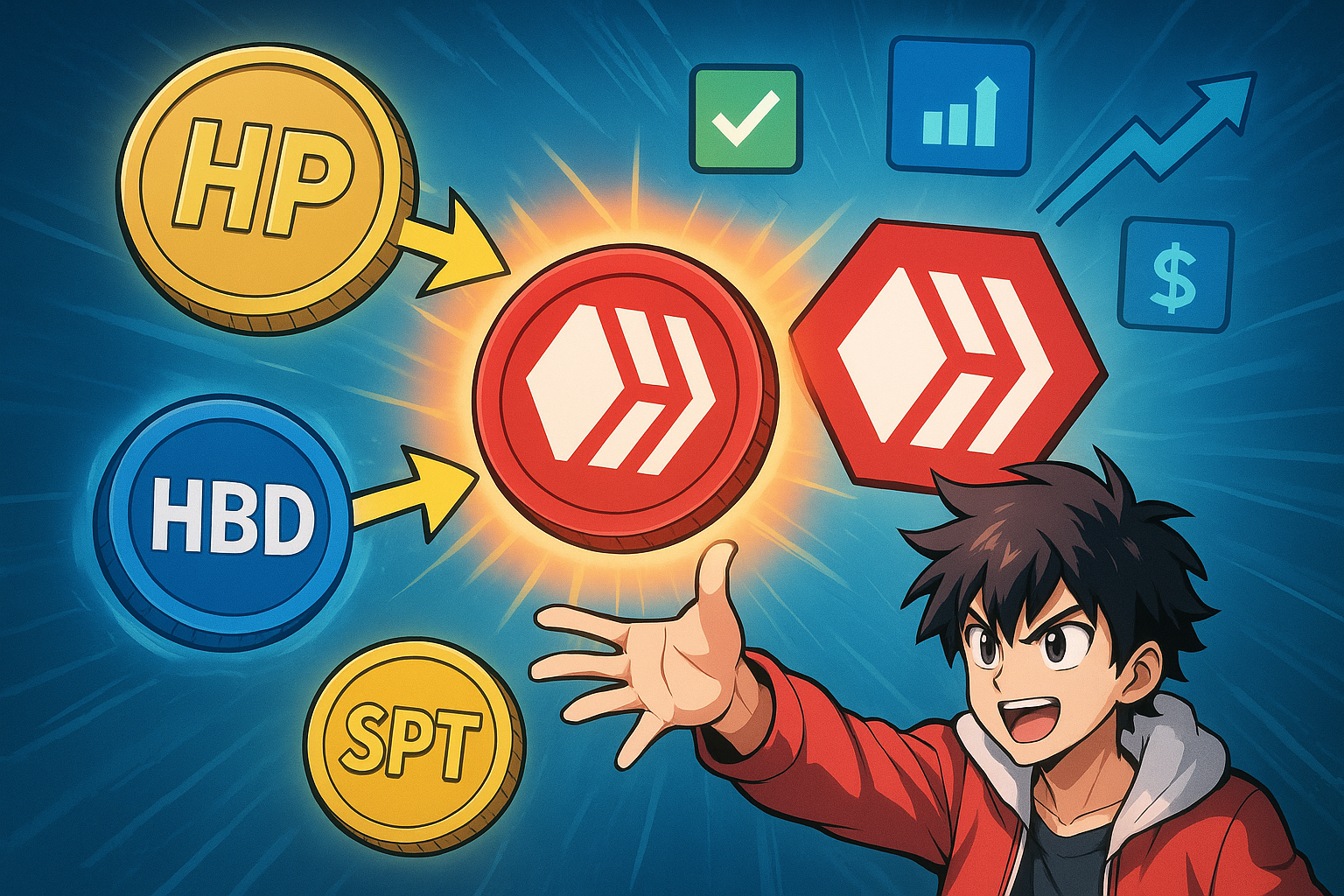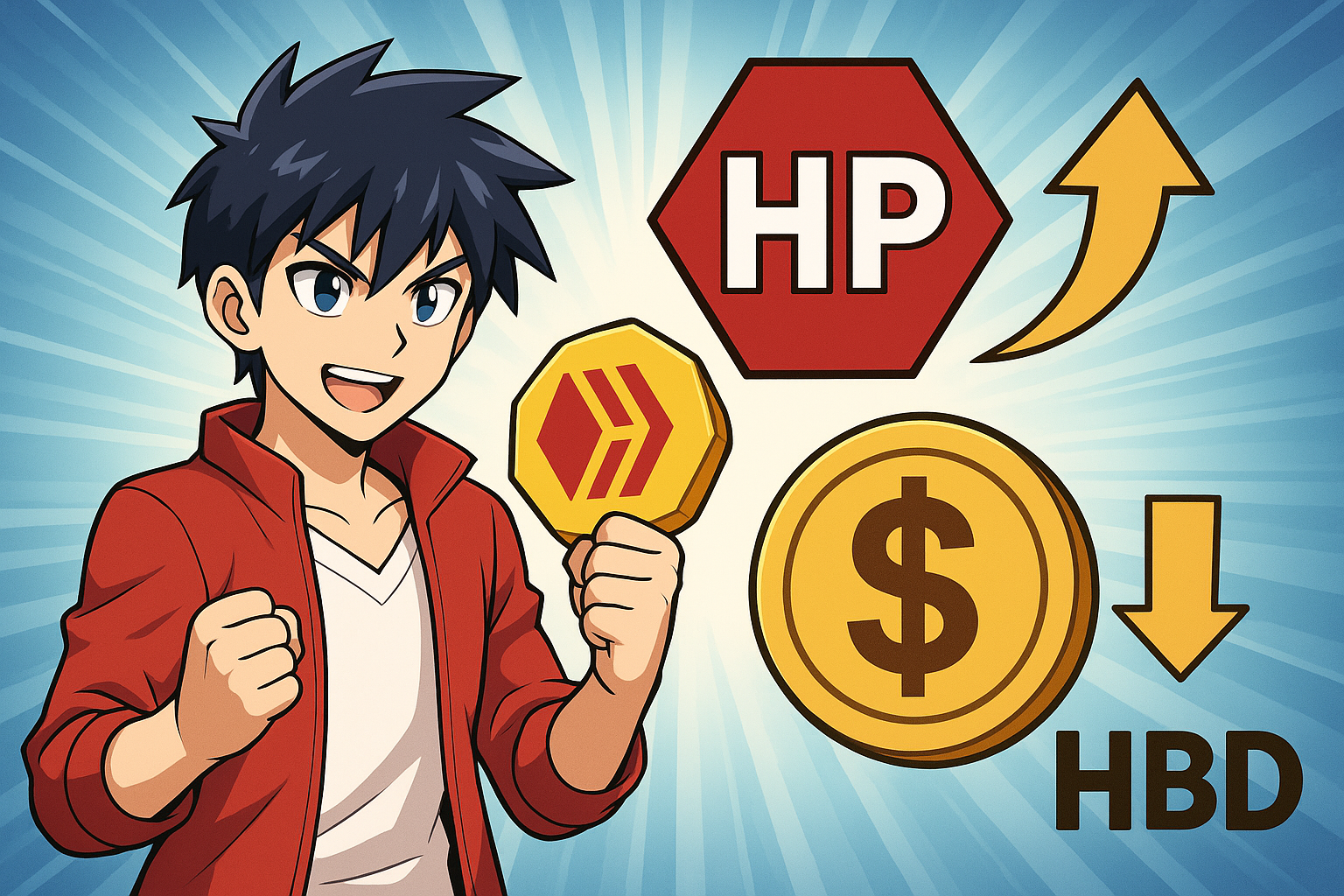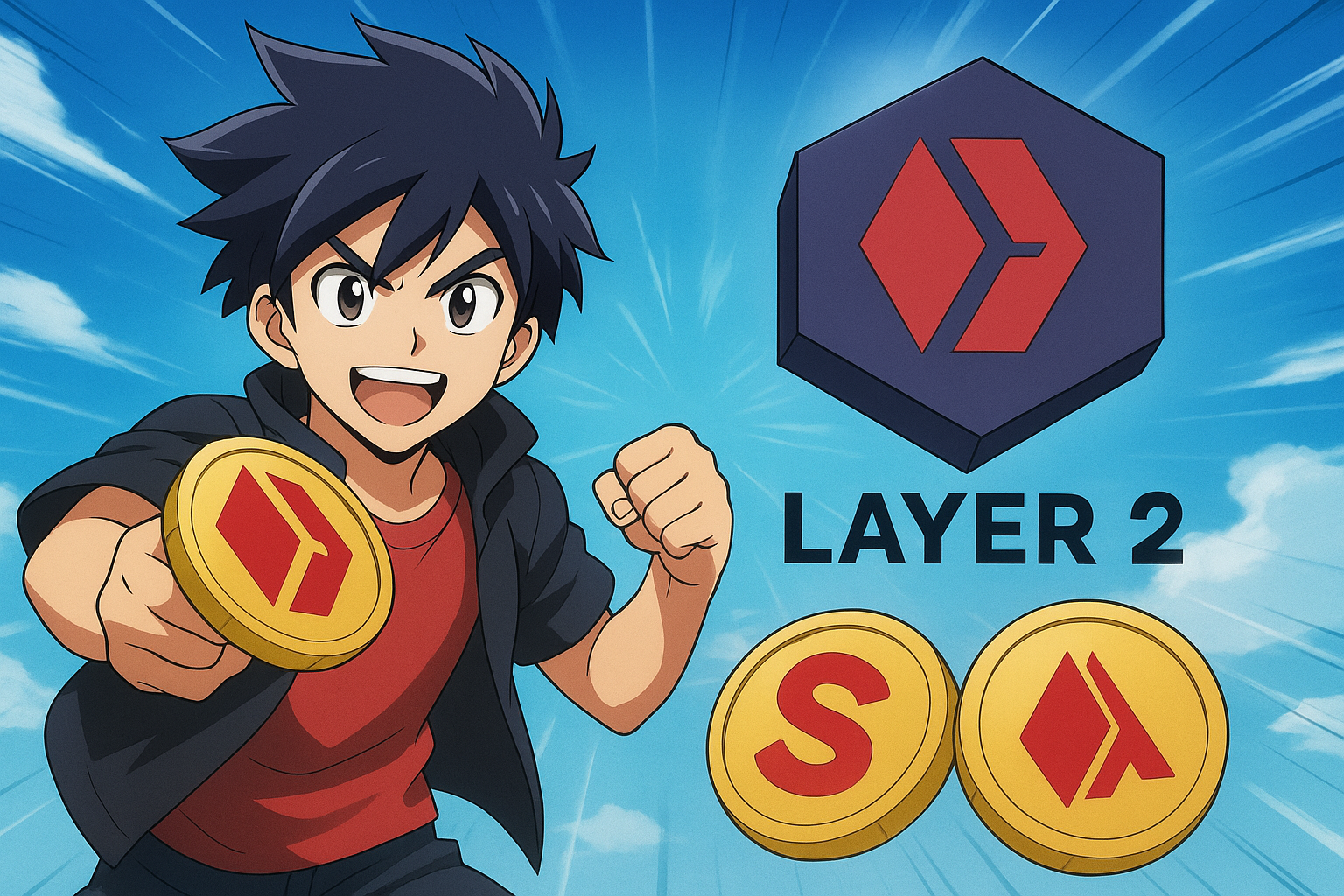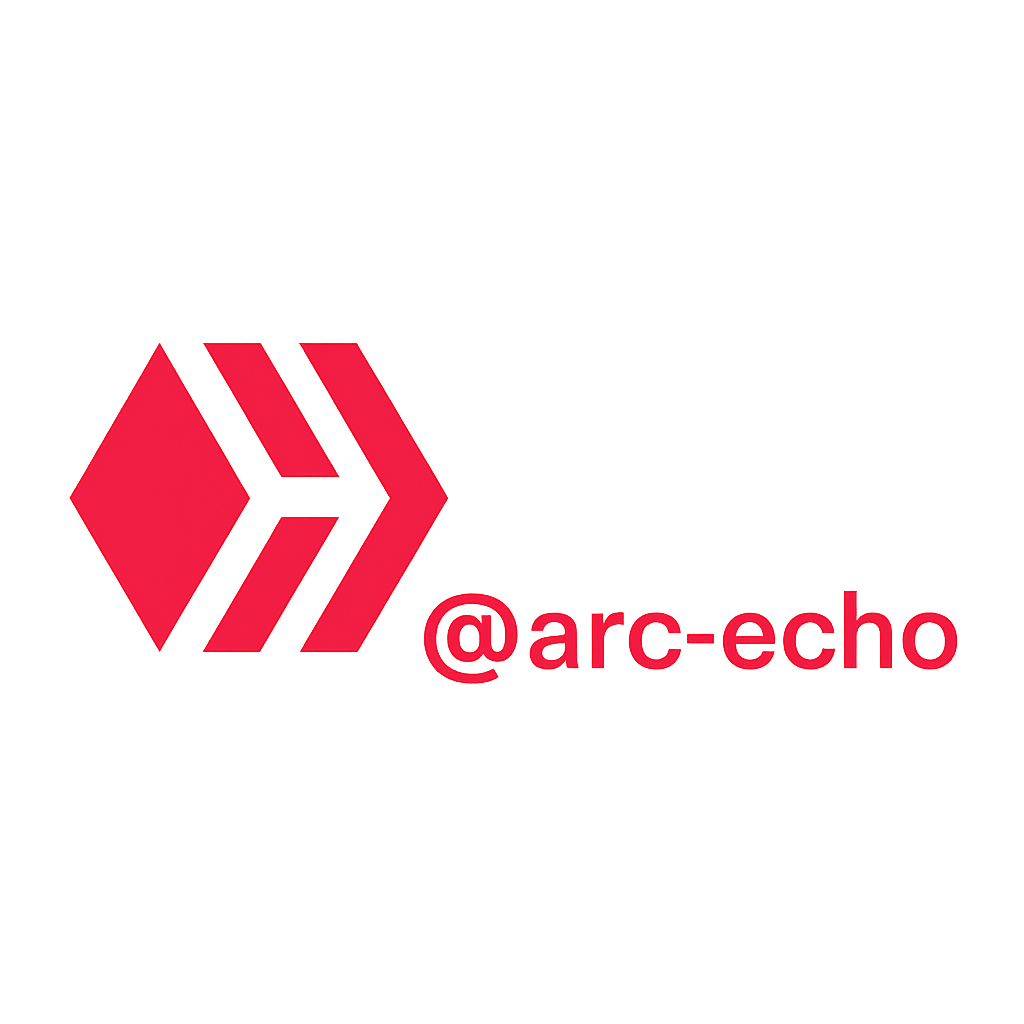Das Token-Ökosystem der Hive-Blockchain

Das Ökosystem der Hive-Blockchain basiert auf mehreren ineinandergreifenden Token-Arten, die gemeinsam ein vielseitiges, dezentrales Wirtschaftssystem bilden.
Im Zentrum steht der native Token HIVE, der als liquid handelbares Kern-Asset des Netzwerks fungiert. HIVE wird für den Handel, als Belohnung und für Governance-Aufgaben eingesetzt. Die jährliche Inflation des Tokens wird alle 250.000 Blöcke um 0,01 % reduziert, was einer Senkung von etwa 0,5 % pro Jahr entspricht. Langfristig strebt das System eine Inflationsobergrenze von 0,95 % an. Die neu erzeugten HIVE-Token werden nach einem festen Schlüssel verteilt: Rund 65 % fließen an Content-Creator und Kuratoren, 15 % gehen an Inhaber von Hive Power, 10 % an den Dezentralen Hive-Fonds (DHF) und weitere 10 % dienen als Blockbelohnung für die Infrastruktur des Netzwerks.
Eine zentrale Rolle im Hive-Ökosystem spielt Hive Power (HP), die gestakte Form von HIVE.
Durch einen sogenannten „Power-Up“ wird HIVE in HP umgewandelt, wodurch sich das Stimmgewicht bei Abstimmungen, die verfügbaren Resource Credits (RCs) und die Belohnungen für Curation erhöhen.
Ein Power-Down, also die Rückumwandlung in liquid HIVE, erfolgt schrittweise über einen Zeitraum von 13 Wochen. HP bietet direkte Belohnungen in Höhe von etwa 3 % pro Jahr allein fürs Halten. Hinzu kommen rund 7–8 % jährliche Erträge durch Curation, was in älteren Berechnungen eine Gesamtrendite von circa 11 % p.a. ergibt.
Für bestimmte Governance-Funktionen wie die Wahl von Witnesses oder das Abstimmen über DHF-Vorschläge ist eine 30-tägige Wartezeit nach dem Power-Up erforderlich.

Ein weiteres wichtiges Element des Ökosystems ist der Hive Backed Dollar (HBD), ein algorithmisch stabil gehaltener Stablecoin, dessen Wert an den US-Dollar gekoppelt ist.
Die Preisbindung wird durch zwei dezentrale Konversionsmechanismen sichergestellt: Bei der Umwandlung von HBD in HIVE erhalten Nutzer nach 3,5 Tagen exakt den Gegenwert von 1 USD in HIVE, ohne dass Gebühren anfallen. Umgekehrt erfordert die Umwandlung von HIVE in HBD eine Hinterlegung von HIVE als Sicherheit. In diesem Fall wird sofort die Hälfte des Werts in HBD ausgezahlt, die Preisfindung erfolgt nach 3,5 Tagen, und die restlichen HIVE werden zurückgegeben. Hierbei fällt eine Gebühr von 5 % in HIVE an, die verbrannt wird.
HBD kann auch in einem Sparkonto angelegt werden, das mit einem 3-tägigen Abhebe-Cooldown aktuell rund 15 % APR bietet. Diese Zinsen werden monatlich gutgeschrieben und können durch Zinseszins-Effekte weiter gesteigert werden. Um die Stabilität zu sichern, greift die sogenannte „Haircut Rule“: Sobald die Menge an HBD mindestens 30 % der HIVE-Marktkapitalisierung erreicht, wird die Emission neuer HBD gestoppt und Konversionen liefern leicht unter dem Nennwert von 1 USD.

Neben diesen Primärtokens existieren zahlreiche Second-Layer-Token, die über die Plattform Hive-Engine erstellt werden können.
Ein bekanntes Beispiel ist SPT im Splintertalk-Ökosystem. Nutzer können solche Token zusätzlich zu HIVE und HBD durch Erstellen oder Kuratieren von Inhalten verdienen. Sie lassen sich staken, oft ebenfalls mit einem 13-wöchigen Power-Down, und gewähren innerhalb ihrer Community spezifische Stimmrechte. Über 100 bis 190 dezentrale Anwendungen und Communities nutzen mittlerweile solche Second-Layer-Assets, darunter Spiele wie Splinterlands, Rabona oder CryptoBrewMaster, soziale Plattformen und NFT-Projekte. Die Einsatzmöglichkeiten reichen von Social-Belohnungen über NFT-Gaming bis hin zu Second-Layer-DeFi-Anwendungen.
Insgesamt bildet dieses mehrschichtige Token-Ökosystem das Fundament der Hive-Blockchain und ermöglicht es, Inhalte, Governance und finanzielle Interaktionen auf einer dezentralen, gebührenfreien Plattform miteinander zu verknüpfen.
---
The token ecosystem of the Hive blockchain

The Hive blockchain ecosystem is based on several interlocking token types that together form a versatile, decentralized economic system.
At its core is the native token HIVE, which acts as the network's liquid tradable core asset. HIVE is used for trading, as a reward, and for governance tasks. The token's annual inflation rate is reduced by 0.01% every 250,000 blocks, which corresponds to a reduction of approximately 0.5% per year. In the long term, the system aims for an inflation cap of 0.95%. The newly generated HIVE tokens are distributed according to a fixed key: Around 65% goes to content creators and curators, 15% goes to Hive Power holders, 10% goes to the Decentralized Hive Fund (DHF), and another 10% serves as a block reward for the network's infrastructure.
Hive Power (HP), the staked form of HIVE, plays a central role in the Hive ecosystem.
Through a so-called “power-up,” HIVE is converted into HP, which increases the voting weight in votes, the available resource credits (RCs), and the rewards for curation.
A power-down, i.e., the conversion back into liquid HIVE, takes place gradually over a period of 13 weeks. HP offers direct rewards of around 3% per year just for holding. In addition, there is an annual return of around 7–8% from curation, which in older calculations results in a total return of approximately 11% p.a.
For certain governance functions, such as the election of witnesses or voting on DHF proposals, a 30-day waiting period after the power-up is required.

Another important element of the ecosystem is the Hive Backed Dollar (HBD), an algorithmically stable stablecoin whose value is pegged to the US dollar.
Price stability is ensured by two decentralized conversion mechanisms: When converting HBD to HIVE, users receive the exact equivalent of USD 1 in HIVE after 3.5 days, without incurring any fees. Conversely, converting HIVE to HBD requires HIVE to be deposited as collateral. In this case, half of the value is paid out immediately in HBD, pricing takes place after 3.5 days, and the remaining HIVE is returned. This incurs a 5% fee in HIVE, which is burned.
HBD can also be invested in a savings account, which currently offers around 15% APR with a 3-day withdrawal cooldown. This interest is credited monthly and can be further increased through compound interest effects. To ensure stability, the so-called “haircut rule” applies: as soon as the amount of HBD reaches at least 30% of the HIVE market capitalization, the issuance of new HBD is stopped and conversions deliver slightly below the face value of USD 1.

In addition to these primary tokens, there are numerous second-layer tokens that can be created via the Hive Engine platform.
A well-known example is SPT in the Splintertalk ecosystem. Users can earn such tokens in addition to HIVE and HBD by creating or curating content. They can be staked, often with a 13-week power-down, and grant specific voting rights within their community. Over 100 to 190 decentralized applications and communities now use such second-layer assets, including games such as Splinterlands, Rabona, and CryptoBrewMaster, social platforms, and NFT projects. The possible uses range from social rewards to NFT gaming to second-layer DeFi applications.
Overall, this multi-layered token ecosystem forms the foundation of the Hive blockchain and enables content, governance, and financial interactions to be linked together on a decentralized, fee-free platform.
All Pictures are created with ChatGPT

 hiveblocks
hiveblocks